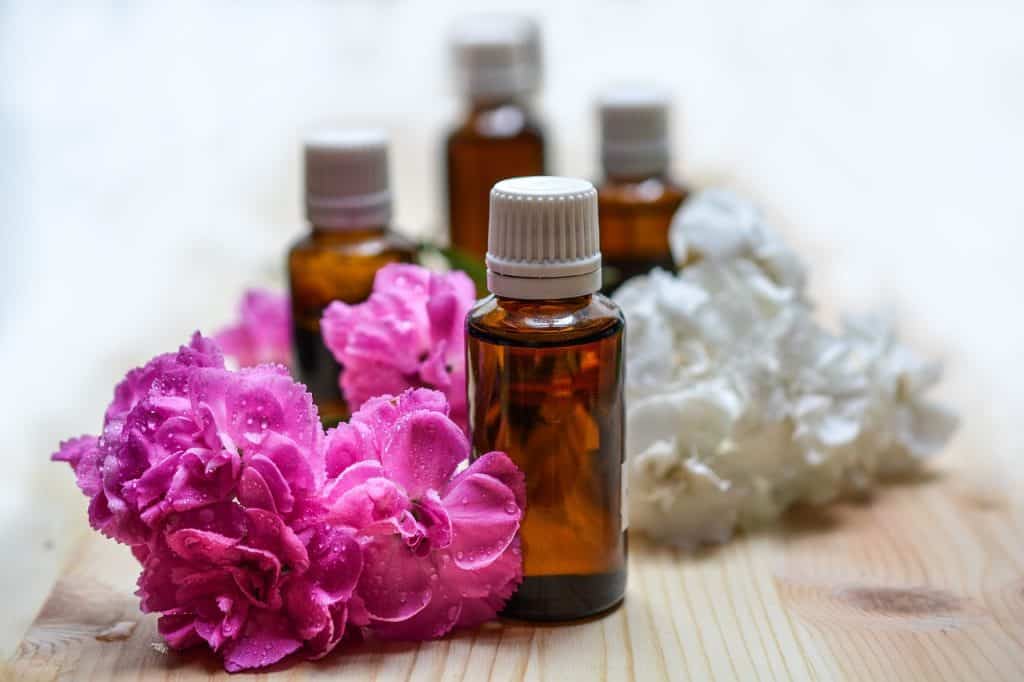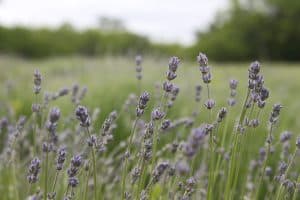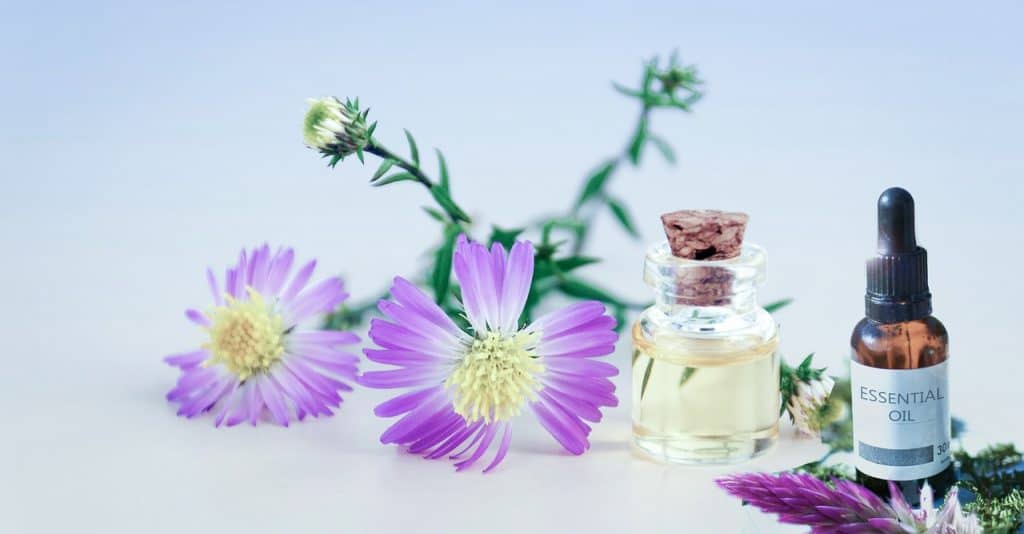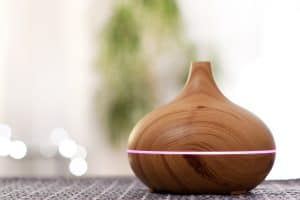
Essential oils are an incredible way to soothe the mind, refresh the body and create a balanced and well-designed atmosphere. Massage therapists have known for years that essential oils are one of the best ways to add an extra calming or rejuvenating touch to a session. A good example of this is lavender’s ability to create a serene space and ease frazzled nerves. Often used to help insomniacs drift off to sleep or anxious people release some tension from their bodies, lavender is one of several essential oils that has a calming quality.
Let’s be honest, in this busy age of text messages, appointments, emails, traffic jams, and online meetings, who couldn’t use a little calm and happiness in their lives?
Contents
Here are five stress-busting essential oils and how to use them
Lavender
 A long-standing favorite, lavender has been touted as a soothing flower for thousands of years. Lavender essential oil is said to help promote healthy sleep, quell panic and anxiety, relax the nervous system (Baser & Buchbauer, 2015), and create a feeling of well-being and inner peace in even the most stressful of times.
A long-standing favorite, lavender has been touted as a soothing flower for thousands of years. Lavender essential oil is said to help promote healthy sleep, quell panic and anxiety, relax the nervous system (Baser & Buchbauer, 2015), and create a feeling of well-being and inner peace in even the most stressful of times.
Chamomile
Often thought of in the form of herbal tea, chamomile essential oil offers similar benefits when used in a diffuser, massage oil, or steam. Chamomile has been shown to not only reduce worry and overwhelming thoughts, but also irritability and depression (Amsterdam, Schults, Soeller, Mao, Rockwell, & Newberg, 2012).
Bergamot
Best known for lending its distinctive scent and flavor to Earl Grey tea, bergamot is a bright, citrus-floral scented oil that reduces corticosterone and shows great promise as both a neuroprotective and an analgesic (Rombola, et. al., 2017). It has also been shown to lift a depressive mood, boost optimism, and keep anxiety at bay. A quick note of caution when using bergamot, it can cause an increased risk of sunburn if used topically within 12 hours of sun exposure.
Ylang Ylang
This custard apple relative has a floral scent that is good for helping a person feel more cheerful and less fearful. Besides a more uplifted outlook on life and less anxiety, ylang ylang has also been studied for its insomnia benefits and its ability to boost self-esteem (Rizzo Gnatta, Piason, De Lion Botero Couto Lopes, Brunet Rogenski & Paes da Silva, 2014).
Orange
This sunny essential oil has long been used to create a sense of happiness, positive thinking, and rejuvenation. It has also been shown in studies to have significant benefits for people living with anxiety, depression, and PTSD (Experimental Biology, 2017).
So what are the best ways to use essential oils?
Massage Oil

To use essential oils on the skin, you will need a carrier oil. A carrier oil is something like almond oil, olive oil, coconut oil, jojoba oil, avocado oil, kukui nut oil, or grapeseed oil. Since many essential oils are too strong to use directly on the skin, carrier oil is a necessity if you are planning to use essential oils during a massage.
To use this technique you’ll want to add about 8-12 drops of essential oil for every ounce of carrier oil. Blend the oils well and apply them to the skin. This is a great way to use essential oils because it will give you not only the benefits of aromatherapy but also the relaxation of a massage.
How to use Essential Oil Diffuser and Sprays
Another good technique for essential oils is using them in a diffuser. Many diffusers are under $20 and are very simple to use. Just fill the diffuser with water, add 3+ drops of essential oil (depending on the size of the diffuser), and turn on the unit. Some diffusers plug into a USB port while others plug into the wall, and their sizes typically vary from 80ml up to 1500ml. If you need to scent a large room, opt for the larger model and increase both the water and the amount of essential oil used.
Essential Oils Distributed
These work fairly quickly and often have a room smelling calm and serene in just a few minutes. This is also a good method for blending several soothing scents into one whole room treatment. If you are hoping to scent a room without the use of electricity, try reed diffusers, terracotta medallions, or candle-based diffusers. All of these options will get the essential oils distributed throughout the room but it may take a bit longer than it would for a larger electric diffuser.

If a diffuser won’t work for you and you’d rather “spot treat” a room, you can always mix your own room spray using essential oils.
Here are the basic ingredients for making a natural room spray:
- Alcohol (most people use vodka)
- Water
- Essential oils
Pour a tablespoon of alcohol into a 4-ounce glass bottle, add 15-25 drops of essential oils, and fill the rest of the bottle with purified water. Shake well and spray everywhere you need a spot of calm.
Bath and Shower
Bathtime is another fantastic way to use essential oils because you are combing the relaxing qualities of a soak in the tub with the benefits of aromatherapy. In a way, using essential oils in the bath is similar to how you would use essential oils during a massage. Blend 8-12 drops of essential oil in every ounce of carrier oil and add the mixture to warm water. The steam from the bath water will act to distribute the scent as you soak away the stress of the day.
If you opt to shower instead of bathe, you can get similar benefits by placing 15-20 drops of essential oil on a small cloth and dropping that cloth into the bottom of the shower. Make sure the cloth can get a bit wet but do not put it directly under the stream of water. After a few minutes, the steam from the water should have the essential oils filling the shower with peace and tranquility.
Essential Oil Basics
References
Amsterdam, J., Schults, J., Soeller, I., Mao, J., Rockwell, K., & Newberg, A. (2012). Chamomile (Matricaria recutita) may provide antidepressant activity in anxious, depressed humans: An exploratory study. Alternative Therapies in Health and Medicine, 18(5), 44-49. Retrieved August 27, 2018, from https://www.ncbi.nlm.nih.gov/pubmed/22894890.
Baser, K., & Buchbauer, G. (Eds.). (2015). Handbook of Essential Oils: Science, Technology, and Applications. Boca Raton, FL: CRC Press.
Experimental Biology 2017. (2017, April 24). The Orange essential oil may help alleviate post-traumatic stress disorder: Researchers find evidence that essential oil reduces fear, and diminishes immune system markers of stress in mice. ScienceDaily. Retrieved August 27, 2018 from www.sciencedaily.com/releases/2017/04/170424141354.htm
Rizzo Gnatta, J., Piason, P., De Lion Botero Couto Lopes, C., Brunet Rogenski, N., & Paes da Silva, M. (2014). Aromatherapy with ylang ylang for anxiety and self-esteem: A pilot study. Revista Da Escola De Enfermagem Da USP, 48(3). Retrieved August 27, 2018, from http://www.scielo.br/scielo.php?script=sci_arttext&pid=S0080-62342014000300492
Rombola, L., Tridico, L., Scuteri, D., Sakurada, T., Mizoguchi, H., Avato, P., . . . Morrone, L. (2017). Bergamot Essential Oil Attenuates Anxiety-Like Behaviour in Rats. Molecules, 22(4). doi:10.3390/molecules22040614
